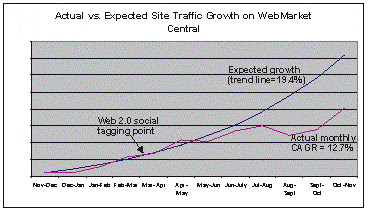Back in May of this year, I reported the results of a test of the impact on B2B website traffic growth using Web 2.0 social tagging. That experiment showed that tagging B2B thought-leadership content on social media sites increased traffic growth for B2B websites by 50%, and on a B2B marketing blog by more than 100%, over 60 days.
So—how do the numbers look six months later? Can these traffic growth gains be sustained?
As shown here, on the B2B website, WebMarketCentral, traffic growth slowed considerably over the summer before posting a fall rebound, ending with a 12.7% monthly growth rate for the year—still a respectable monthly traffic growth rate, but well below the trend line following the social tagging activity.
 The traffic change on this blog, however, showed a much different pattern. As shown below, after six months, the growth rate continued to show nearly a 50% increase even after six months, from 8.0% to 10.9%.
The traffic change on this blog, however, showed a much different pattern. As shown below, after six months, the growth rate continued to show nearly a 50% increase even after six months, from 8.0% to 10.9%.
Three conclusions from this:
1) The effect of social tagging on B2B website traffic, even for thought-leadership content, is primarily a short-term bump in the traffic growth rate (though there are some positive long-term SEO effects as well). This pattern was similar over several B2B websites tested.
2) Most B2B websites show a flattening of traffic growth over the summer months, with perhaps even a traffic dip in August, followed by an autumn rebound. This pattern held for every B2B website I tracked (except one—a software application targeted at government buyers, which may have a different pattern from the private sector market).
3) Social media tagging appears to have a significant, sustained effect on traffic growth for blogs.
The lesson for B2B companies: blogging may be hard work requiring consistent effort, but it is worthwhile for establishing a thought leadership position in your industry. While developing relevant content for your corporate website is still important for PR and SEO purposes, writing and promoting a blog establishes credibility in a way that articles viewed as "vendor content" can't. Social media tagging on sites such as ClipMarks, Searchles, Digg and Zimbio can have positive effects on your website traffic, but has a much larger effect on driving increased traffic to a thoughtful and relevant industry blog.
*****
Contact Mike Bannan: mike@digitalrdm.com

Comments